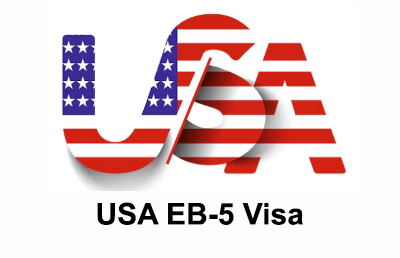EB-5 Immigrant Investor – USA
Our Role in Assisting you: EB-5 Visa:
- Evaluate eligibility, assist with investment structuring, and assist in preparing application documents.
- Assist in understanding on Regional Center selection, conduct due diligence, and ensure legal compliance.
EB-5 Final Rule Changes:
- Effective November 21, 2019, minimum investment amounts increased to $900,000 for TEAs and $1.8 million elsewhere.
- Stricter criteria for TEA designation shifted authority from states to DHS.
- Impact on Regional Centers due to reduced TEA availability.
Handling Applications Before November 21, 2019:
- Applications submitted prior to this date will be processed under previous regulations.
- Processing times vary, and staying informed is crucial.
Benefits of EB-5 Visa over Other Options:
- No labor certification, business maintenance requirements, or country-based quotas.
- No exceptional commercial acumen needed, and a direct path to citizenship is available.
Conditions for EB-5 Immigrant Investors:
- Choose a regional center, invest, submit Form I-526, undergo USCIS approval, consular processing, and obtain conditional residence.
Demonstrating EB-5 Petition:
- Show new business establishment, capital investment, legally obtained funds, job creation, and intent to reside.
Anticipated Steps for EB-5 Filers:
- File Form I-526, obtain conditional residence, fulfill investment and job creation requirements, file Form I-829, and obtain permanent residence.
Benefits of Targeted Employment Areas (TEAs):
- Lower investment threshold of $900,000, advantageous for capital-restricted applicants.
- Stricter TEA criteria may impact project availability, necessitating guidance from EB-5 attorneys.
Importance of Acting Promptly:
- Increased demand and potential age-out issues underscore the need for timely action.
- Potential program reforms may impose stricter conditions, emphasizing the importance of filing before changes occur.
FAQ
What advantages does an EB-5 Green Card offer over other visas?
Permanent residency, educational opportunities, absence of language requirements, and a pathway to U.S. citizenship after five years make it an attractive option.
What is the total cost of the EB-5 process?
The total cost includes a minimum investment of $800,000 or $1,050,000, administration fees ranging from $40,000 to $100,000, legal fees of $15,000 to $25,000, and a USCIS filing fee of $3,675.
What ROI can investors expect from their EB-5 investment?
ROI ranges from 0.25% to 8% per annum, considering program aspects and benefits of permanent residency.
How can investors identify suitable EB-5 projects?
Research, recommendations, and due diligence help find suitable projects. Personal visits and thorough project evaluation are crucial.
What is the typical timeframe for filing an I-526 petition?
Filing takes one to two months, but may extend to six to eight months based on various factors.
What are the steps for obtaining an EB-5 Green Card?
Steps involve selecting a project, filing an investor petition (Form I-526), applying for conditional residency (Form I-485 or DS-260), and filing to remove conditions (Form I-829) after a specified period.
Can EB-5 investments involve loans?
No, EB-5 investments must be equity-based, meaning investors become partial owners of the entity they invest in. This arrangement offers potential financial gain but also carries the risk of loss.
Can gifted funds be used for the $800,000 EB-5 investment?
Yes, gifted funds are acceptable for EB-5 investments, but thorough documentation is needed to comply with USCIS regulations, including a gift letter and evidence of lawful fund transfer.
Can I get a loan for my EB-5 investment?
Yes, loans can be used for an EB-5 investment, but they must be unsecured and not tied to the investment project itself.
In case of EB-5 petition denial, is investors' money returned immediately?
Most investments have refund provisions, but conditions vary. Investors should review documents and seek guidance.
Can one transition from an E-2 visa to EB-5?
Yes, by increasing the investment to meet EB-5 requirements and ensuring job creation.
What factors affect success in the EB-5 program?
Thorough due diligence, compliance with program requirements. Project evaluation, compliance, and developers' reputations play critical roles.
What happens if the EB-5 petitioner passes away?
Consultation with an immigration attorney is crucial to understand options regarding the fate of the Green Card and invested funds.
Can my own business be my EB-5 investment?
Yes, known as a "direct investment," but it requires all job creation to be directly tied to the business itself.
When can investors expect the return of their EB-5 funds?
Timing varies based on loan repayment and NCE liquidation. Investors should review agreements and seek professional guidance.
Can parents be included as derivatives in an EB-5 petition?
No, only spouses and unmarried children under 21 years old qualify as derivatives for EB-5.
Can H-1B visa holders apply for EB-5?
Yes, but maintaining lawful status during the EB-5 process is crucial. Consulting with immigration attorneys is advisable.
What are the travel restrictions during the EB-5 process?
Generally, individuals with a pending I-526 petition can travel in and out of the U.S., but complications may arise for H-1B visa holders due to expressed immigrant intent.
Note: “The information herein is provided for informational purposes only and should not be construed as legal advice. Read our complete Legal Disclaimer on Website”

